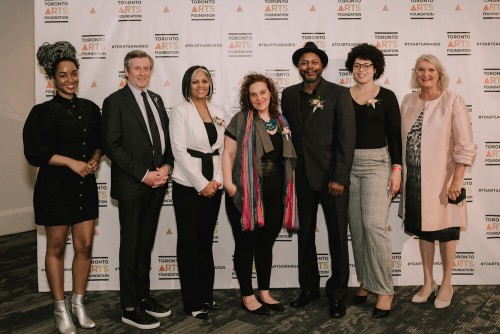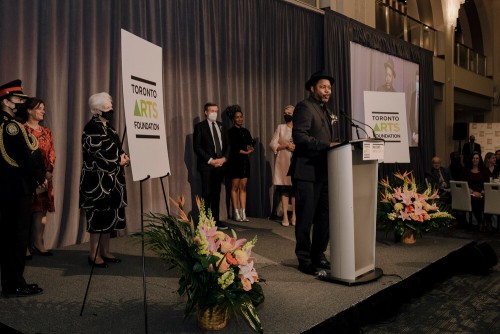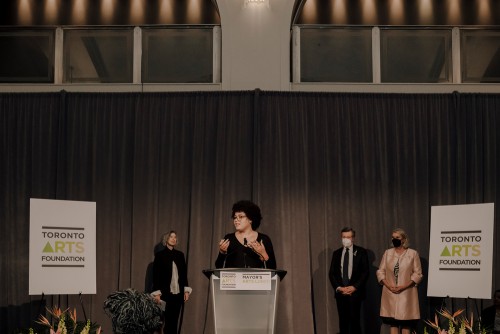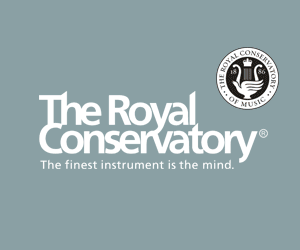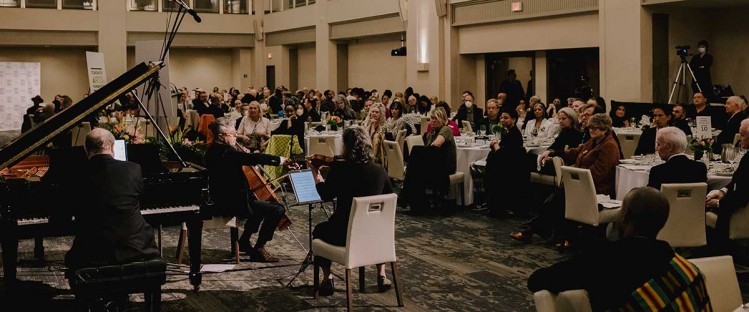 Nestled in every story is another story, like those wooden dolls hidden within selves. The festively decorated Arcadian Court was the site of this past April’s Toronto Arts Foundation Awards. The event, also referred to as the Mayor’s Lunch, has been a part of the Toronto arts ecosystem since 1996. The venue, located in what was then the Robert Simpson Company Store, at Queen and Bay, has been part of the city’s social, cultural and commercial fabric since the 1930s.
Nestled in every story is another story, like those wooden dolls hidden within selves. The festively decorated Arcadian Court was the site of this past April’s Toronto Arts Foundation Awards. The event, also referred to as the Mayor’s Lunch, has been a part of the Toronto arts ecosystem since 1996. The venue, located in what was then the Robert Simpson Company Store, at Queen and Bay, has been part of the city’s social, cultural and commercial fabric since the 1930s.
The large crowd in attendance included the Mayor of course, at the head table at the front of the room, along with Claire Hopkinson, Director and CEO of the Toronto Arts Foundation and its sister organization, the Toronto Arts Council, many financial donors to the arts, city councillors, and the event host, award-winning writer, producer and tv/radio host, Amanda Parris.
The Lunch
Round, white-table-clothed tables fill the rest of the room, each seating about ten guests. The finalists for the Toronto Arts Foundation’s Celebration of Cultural Life Award, Breakthrough Artist Award and Arts for Youth Award are interspersed among others like me, who have various links to the arts. So are representatives of Meridian, Ontario’s largest credit union, on hand to accept the already-decided Toronto Arts and Business Award in recognition of their ongoing program of providing transformational cultural funding to the communities they serve.
After some speeches, it’s time to eat. They feed us well and I chat with my table mates, a lustrous group of artists, arts administrators, heads of arts organizations, theatre directors, arts professors, and so on. After lunch, the brilliant Gryphon Trio plays Fugitive Visions of Mozart by Ukrainian composer, Valentin Silvestrov, followed by a tango, La muerte del ángel by Astor Piazzolla from Argentina. And then it’s time for the finalists to be recognized.
Even within a celebratory scenario such as this – the opening of envelopes and announcing of winners – the structure of a system is hard to ignore. Throughout the ceremony I’d noted the use of space (the stage), the use of time (1.5 hours) — who speaks and for how long. In particular, those opening envelopes, announcing winners and handing out monetary awards – the benefactors – were not reflective of the majority of people at the other tables in the room. There is a tale and a history hitting us in the face if we care to notice.
The Process
Initially, when asked to attend and write on the gathering, I wondered about the nomination and assessment process as the finalists seemed so vastly different in art form/contributions. I wondered how they could be assessed on the same criteria. I wondered where the Indigenous artists were. I went to the Toronto Foundation Arts and Toronto Arts Council staff to find out. They were forthcoming and thoughtful in their responses.
“Our outreach is mostly through emails,” says Jaclyn Rodrigues, Community Engagement Manager at the Toronto Arts Foundation.
The outreach team reaches out to past award recipients, board members, artistic directors, educational directors and the board presidents of organizations. “We also have a social media toolkit that we share with our local arts service organizations, as well as other various service organizations in Toronto such as East End Arts, Scarborough Arts, Lakeshore. We send targeted communications to past recipients like the Paprika Festival, artist resource centres like the Dancer Transition Resource Centre or Dance Umbrella of Ontario, Playwrights Guild of Canada and other organizations that kind of maybe have a membership network … The nomination process is not like the grant application process. It’s very simple, it’s usually a handful of questions plus contact information. That’s something we stress when reaching out to smaller organizations that might have lower capacity.”
Liza Mattimore, the Award Program Manager at Toronto Arts Foundation, also participates in this exercise. She adds that there were more nominations during the pandemic: “Perhaps people were not doing programming and had time to consider the application, and had capacity to consider a nomination.”
This year however, the organization noted a decline in the number of nominations. Mattimore suggests that “perhaps people were ramping back up trying to get their programming going again.”
In response, she and other staff made a lot of personal calls to organizations that had received the awards and had experienced the benefit of them. “I also reached out to organizations that had some extra momentum, or for whom there was more interest building in their work, as well as to newer organizations, as we’ve got the Arts for Youth Award this year. We also have the Celebration of Cultural Life Award. So, I reached out to some strategic people to ask them to please feel free to consider nominating someone. It’s a combination of all of the individual staff members kind of doing their reach outs. We send out emails to all of our grant recipients, so it’s a pretty wide net that we cast, but I think there’s always room for improvement for sure.”
The Panel
Looking at the list of nominees for the Celebration of Cultural Life, for example, I found myself wondering how it might be possible to pick between a flamenco dancer and a writer and a woman who’s been an arts administrator for many years. The way a selection panel is chosen seems to be a key process.
Mattimore waits until the nominations are closed and only then looks for panel members: “I try to make sure that all of the disciplines that are nominated are reflected in the panel. We have an equity charge in terms of the makeup of our panels. I also like to think broader than that too. I like to think about generational differences and people in different places in their career. I always like to have people in the panel who have received awards — different awards, not necessarily only ones that we’re considering. I find that those people are often very thoughtful panelists, because again, they have this intuitive understanding of how powerful the awards can be. I try to reflect the communities within Toronto, not just the core downtown. I want to have panelists who are living and working in Scarborough and living and working north of the 401 and who are living and working in Weston, areas that are not necessarily always well reflected even in the nominations themselves.”
Each of the panelists selects a shortlist. “We also create space to have conversations about other nominations that are of note that we think need to be discussed. Ultimately, I found all of the panels come to consensus. This year in particular, there was very little dissent among the panelists about who should be the finalists and who should be the recipients.”
Who sits around each table?
Early on, I had wondered where the Indigenous artists were amongst the finalists for the group of awards being presented at this lunch. Hasanika Mediwake, Program Outreach Coordinator at Toronto Arts Foundation, spoke to this: “When I was doing outreach for these awards, I also included all our contacts we reached out to for the Indigenous Artist Award. And, I made sure to let them know about it and include them in any communications. However, I think the number of Indigenous artists accessing our resources is pretty low across the board. It’s something that we really need to think deeper about. And I’m so grateful to Catherine Tammaro, the Indigenous Arts Program Manager at the Toronto Arts Council – the two organizations work very closely together. She’s giving us opportunities and resources on how to do that better. Rather than just letting people know about this opportunity, we need to really get into the community and build trust, and that’s more of an individual approach.”
Catherine Tammaro’s role is similar to that of Liza Mattimore’s in that she coordinates award processes and panels. She informed me that the Indigenous Artist Awards (a new TAF initiative) ceremony was a great success. She approached communities with care and the result was a tremendous celebration. “There was a lot of love in that room.” Nominees, finalists and winners enjoyed a context where they felt that their work was deeply understood.
New ways of doing outreach and new types of awards are always in the works. Sometimes the key is changing the name of an existing award, and along with the name change, a change in focus. The Breakthrough Artist Award is a good example. It was formerly called the Emerging Artist Award and it used to have an age restriction, but “there’s nothing in being an early career artist, as that assures that you are also young,” says Mattimore. “It was noted that the age restriction disproportionately impacts women, negatively impacts people of colour and anyone who [is] not earning top dollar.”
There are deeper issues, she says: “The problem with the arts is that it represents all of these, the systemic racism and systemic kind of disadvantages that happen in the rest of society in a more visible way. We’ve seen changes in the art [that is] in front of audiences, more than we’ve seen changes happening behind the scenes.”
Arts organizations are hugely class-divided, Mattimore says. “In order to be a working artist, you have to come from money. Unfortunately that still prevails. If you’re going to work at it [art], it’s because you don’t have the same stresses of housing, employment and being able to pay for food. We still see that in who’s represented, across arts disciplines, and often also in these awards. Saying that you can be a breakthrough artist at any age helps to try to undermine some of those systemic disadvantages.”
Deeper works
These awards are important. They are career sustainers and career makers for some. They provide financial support, a sense of legitimacy for others, and they certainly raise an artist’s profile. Also arts awards, unlike grants, are not taxable!
And yet, as Mattimore says, “There is work to do. I think there are always ways that we can honour and acknowledge the process that we have and how it works, but also try to find out where we can make things better. Who’s not in the room? How can we get more people to put forward nominations, to feel empowered, to know that they have a voice in our arts community.”
These are discussions already underway amongst TAF and TAC panels that are already moving awareness and focus towards such inclusion: for example the Muriel Sherrin Award, another of Toronto Arts Foundation’s initiatives, that oscillates each year between dance and music. Notably in 2021, “even though there was a record number of nominations, there was a conversation among the panellists on who was missing, who was not on this list, who’s not being nominated, and how can we better reach them,” Mattimore says. “I know it’s frustrating for us and frustrating for the Toronto Arts staff because they work really hard to get that information out there.”
In the next breath, she provides a possible solution. “I think a big part of it is on us. There’s only so much that you can do through zoom and digital means. You need to be there, you need to be in those places, you need to actually be at those community centres or connecting with people at the library.”
Turning the tables
Who gets to sit at all the tables that together make up the system is something that needs to continue to change. What will that kind of change begin to look like? For one thing, succession planning, team leads, department heads and organization leaders – the benefactors, as I referred to them earlier – will better reflect the beneficiaries at the round tables in Arcadian Court back in April. Earlier, Mattimore mentioned that when nomination numbers are low, staff reach out personally to former winners to spread the word. Perhaps there is an opportunity to formalize this work further. Perhaps finalists who do not win can be pulled further into the fold as paid cultural ambassadors who can reach out to contacts throughout the year. This would help ensure co-creation and early inclusion in the process. In that way the face of systemic change can look more like musician Jesse Ryan, winner of the Emerging Jazz Artist Award 2020, who now sits on the Foundation’s Board.
There continues to be cultural value in coming together whenever we can and under any guise. I don’t usually quote politicians, but this was a good one: “Increasing polarization is resisted via arts and culture. We can disagree and stand together at a concert or performance,” said Mayor John Tory. And, as Dwayne Morgan, winner of the Celebration of Cultural Life Award spoke, I covertly wiped away a tear or two with the edge of a napkin when he let us know that he usually invites his daughter to perform with him and he pays her to do so. This is so that she understands that art is a vocation for which you should be paid. Art, in addition to art for the sake of beauty and expression, also has deep economic value to any culture and must be included as such.
The winner of the Arts for Youth Award, the organization Never Gallery Ready focuses on media analysis for young people. They develop a capacity for analysis, to deconstruct and to note what systems are right in front of our eyes and how they are sustained and repeated. This is also art. As Dwayne Morgan said in accepting his Celebration of Cultural Life Award: “You have to build the door that opportunity knocks on.”
Meanwhile, however much their systems and processes can be improved, these awards are a crucial affirmation of the power of creativity. They acknowledge and help fund the deep work of artists in the act of building and sustaining our hearts. In the jubilant words of the winner of the Breakthrough Artist Award, Shelly Grace: “Peace, power and poetry. Off.”
Gloria Blizzard is a non-fiction writer, poet and penner of songs, whose essays, reviews and articles have appeared in numerous literary publications, magazines and sound recordings, including Poetry Canada Review, cbc.ca, The Globe and Mail, Humber Literary Review and World Literature Today. She is working on her first full-length book of essays. Instagram: @gloriawrites; Twitter: @gloriablizzard


